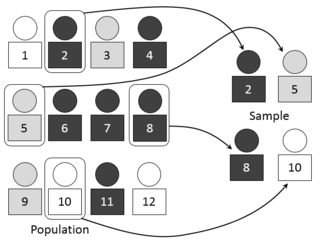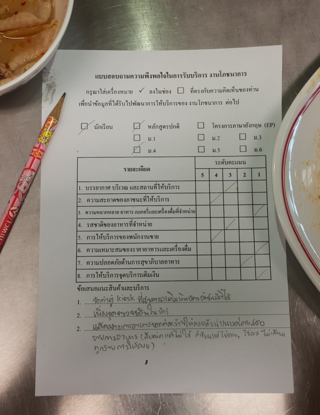
In statistics, quality assurance, and survey methodology, sampling is the selection of a subset or a statistical sample of individuals from within a statistical population to estimate characteristics of the whole population. Statisticians attempt to collect samples that are representative of the population. Sampling has lower costs and faster data collection compared to recording data from the entire population, and thus, it can provide insights in cases where it is infeasible to measure an entire population.
Marketing research is the systematic gathering, recording, and analysis of qualitative and quantitative data about issues relating to marketing products and services. The goal is to identify and assess how changing elements of the marketing mix impacts customer behavior.
Questionnaire construction refers to the design of a questionnaire to gather statistically useful information about a given topic. When properly constructed and responsibly administered, questionnaires can provide valuable data about any given subject.
Survey methodology is "the study of survey methods". As a field of applied statistics concentrating on human-research surveys, survey methodology studies the sampling of individual units from a population and associated techniques of survey data collection, such as questionnaire construction and methods for improving the number and accuracy of responses to surveys. Survey methodology targets instruments or procedures that ask one or more questions that may or may not be answered.
Quantitative marketing research is the application of quantitative research techniques to the field of marketing research. It has roots in both the positivist view of the world, and the modern marketing viewpoint that marketing is an interactive process in which both the buyer and seller reach a satisfying agreement on the "four Ps" of marketing: Product, Price, Place (location) and Promotion.

The American Community Survey (ACS) is an annual demographics survey program conducted by the U.S. Census Bureau. It regularly gathers information previously contained only in the long form of the decennial census, including ancestry, citizenship, educational attainment, income, language proficiency, migration, disability, employment, and housing characteristics. These data are used by many public-sector, private-sector, and not-for-profit stakeholders to allocate funding, track shifting demographics, plan for emergencies, and learn about local communities.

A questionnaire is a research instrument that consists of a set of questions for the purpose of gathering information from respondents through survey or statistical study. A research questionnaire is typically a mix of close-ended questions and open-ended questions. Open-ended, long-term questions offer the respondent the ability to elaborate on their thoughts. The Research questionnaire was developed by the Statistical Society of London in 1838.
The General Social Survey (GSS) is a sociological survey created in 1972 by the National Opinion Research Center (NORC) at the University of Chicago and funded by the National Science Foundation. The GSS collects information biannually and keeps a historical record of the concerns, experiences, attitudes, and practices of residents of the United States.
The National Longitudinal Surveys (NLS) are a set of surveys sponsored by the Bureau of Labor Statistics (BLS) of the U.S. Department of Labor. These surveys have gathered information at multiple points in time on the labor market experiences and other significant life events of several groups of men and women. Each of the NLS samples consists of several thousand individuals, many of whom have been surveyed over several decades.
The U.S. Import and Export Price Indexes measure average changes in prices of goods and services that are imported to or exported from the U.S.. The indexes are produced monthly by the International Price Program (IPP) of the Bureau of Labor Statistics. The Import and Export Price Indexes were published quarterly starting in 1974 and monthly since 1989.
Automated telephone surveys is a systematic collection a data from demography by making calls automatically to the preset list of respondents at the aim of collecting information and gain feedback via the telephone and the internet. Automated surveys are used for customer research purposes by call centres for customer relationship management and performance management purposes. They are also used for political polling, market research and job satisfaction surveying.
The Survey of Consumer Finances (SCF) is a triennial statistical survey of the balance sheet, pension, income and other demographic characteristics of families in the United States; the survey also gathers information on the use of financial institutions.

In research of human subjects, a survey is a list of questions aimed for extracting specific data from a particular group of people. Surveys may be conducted by phone, mail, via the internet, and also at street corners or in malls. Surveys are used to gather or gain knowledge in fields such as social research and demography.
A mall intercept is a quantitative research survey whereby respondents are intercepted in shopping malls or other public spaces. The process involves stopping shoppers, screening them for appropriateness, and either administering a survey on the spot or inviting them to a research facility nearby to complete the interview. Mall intercepts are frequently used as a type of marketing research.
SHARE-Israel is the Israeli component of the Survey of Health, Ageing and Retirement in Europe, a multidisciplinary and cross-national panel database of micro data on health, socio-economic status as well as social and family networks of individuals aged 50 or over.
The Health Information National Trends Survey (HINTS) is a cross-sectional, nationally representative survey of American adults sponsored by the National Cancer Institute. HINTS provides publicly available data on American adults' knowledge of, attitudes toward, and behaviors related to cancer prevention, control and communication. Researchers use the data to identify trends in health communication, including how people find cancer information, which sources they use, their feelings about the search process, and how they perceive cancer overall.
The Panel Study of Income Dynamics (PSID) is a longitudinal panel survey of American families, conducted by the Survey Research Center at the University of Michigan.
Mode effect is a broad term referring to a phenomenon where a particular survey administration mode causes different data to be collected. For example, when asking a question using two different modes, responses to one mode may be significantly and substantially different from responses given in the other mode. Mode effects are a methodological artifact, limiting the ability to compare results from different modes of collection.
With the application of probability sampling in the 1930s, surveys became a standard tool for empirical research in social sciences, marketing, and official statistics. The methods involved in survey data collection are any of a number of ways in which data can be collected for a statistical survey. These are methods that are used to collect information from a sample of individuals in a systematic way. First there was the change from traditional paper-and-pencil interviewing (PAPI) to computer-assisted interviewing (CAI). Now, face-to-face surveys (CAPI), telephone surveys (CATI), and mail surveys are increasingly replaced by web surveys. In addition, remote interviewers could possibly keep the respondent engaged while reducing cost as compared to in-person interviewers.
The first Federal population census in Switzerland took place in March 1850 under the direction of Federal Councillor Stefano Franscini. As well as counting the number of inhabitants, respondents were also asked about their sex, age, marital status, occupation and religion. Between 1860 and 2000, a census took place every ten years in December. The only exceptions to this 10-year rhythm were the population census of 1888 and the population census of 1941. The census of 2000 was the last to use traditional methods. Since 2010, the population census has been carried out and analysed annually in a new format by the Federal Statistical Office (FSO). In order to ease the burden on the population, the information is primarily drawn from population registers and supplemented by sample surveys. Only a small proportion of the population are surveyed in writing or by telephone. The first reference day for the new census was 31 December 2010.



